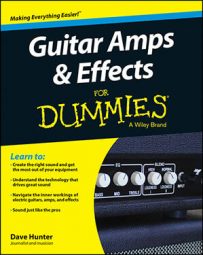Whatever kind of sound you’re after, it all starts with your guitar. Make no mistake, an electric guitar can’t make any sound without the rest of your equipment, other than a thin, soft jangle.
But when you plug it into an amp (and any effects you use in between), it feeds a signal to the truly electric parts of your rig, and that signal determines the fundamental nature of the sound that comes out the other end, however much it’s shaped along the way.
The signal that your guitar sends farther up the chain is determined by what goes into making that guitar in the first place — as well as, of course, how you play it. But the woods, hardware, electronics, and even the strings you use play an enormous role in shaping the little low-voltage electrical signal that comes out of your guitar and goes into everything else down the line, and the shape of that signal determines the core of your tone.
In addition to what goes into your guitar, its condition, setup, and action (its playing feel, determined by the height of the strings from the frets) have a huge impact on its feel and tone.
Variations in guitar designs
The sound of any electric guitar is established largely by the fundamentals of its design and construction and the ingredients that go into making it. The following blueprint elements determine the tonal ballpark of the instrument, which is only tweaked or enhanced — but not drastically altered — by whatever else goes into it:
Body style: Solid, semisolid (that is, semi-acoustic), and entirely hollow electric guitars all have different personalities.
Scale length: Guitars of different scale lengths (the length of the part of the string that vibrates when you play) have somewhat different characters.
Neck attachment: Guitars that have necks attached with wood screws sound somewhat different from those with glued-in necks, all else being equal (not better or worse, just different).
In addition to these basics, the woods used to construct a guitar’s body, neck, and fingerboard all play an important part in shaping its sound. The density, weight, rigidity, grain, vibrational characteristics, and other factors all play a part.
Pickups and electronics
Your guitar generates the fundamental sonic characteristics of every note you play, but the pickups are the part that makes it electric. Pickups are simple, passive electromagnetic devices, motion sensors essentially (in the early days, many guitar makers even called them mics). They consist of magnets and coils of wire, which produce a low-voltage electrical signal when the movement of a steel string interrupts their magnetic field.
There are many, many different types and makes of pickups out there — the field is huge and really has been booming lately — and different types of pickups offer their own very different sonic personalities on top of the fundamentals generated by the guitar’s body design and woods.
A simple change in pickups can make a guitar sound brighter, darker, deeper, bigger, hotter, and all sorts of other things. Your electric guitar tone options expand exponentially depending on the pickups you put into it.
Hardware
Hardware refers to the metal components that are attached to your guitar, most of which play some part or other in keeping the strings anchored and keeping them in tune.
Different types of hardware — most notably, guitars’ bridges, tailpieces, and tuners — clearly have an impact on the functionality of the guitar in question: how you tune it up, how you adjust its playing feel, and so forth.
Because they are the contact points for the strings, and that’s where your sound originates, these components also greatly affect the sound of your guitar. Different designs of bridges, for example, and those made from different materials (such as steel or wood) contribute to very different-sounding guitars.
There’s a whole big, wonderful world of guitar hardware and components out there that you may not have considered previously but which needs to be accounted for if you want to dial in your tone.

